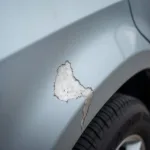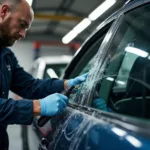Knowing when to use spray paint for car repair can save you time and money. While some scratches and blemishes might require a professional touch, others can be easily tackled with a DIY approach using spray paint.
This guide will help you determine whether spray paint is the right solution for your car repair needs, provide expert tips for a flawless finish, and answer frequently asked questions about spray painting your car.
Assessing the Damage: Spray Paint or Professional Help?
Before heading to the auto shop, assess the severity of the damage. Spray paint is an excellent option for:
- Minor scratches and chips: Surface-level scratches that haven’t penetrated the primer can often be addressed with touch-up paint and clear coat.
- Small areas of fading or oxidation: Sun damage can dull your car’s paint. Spray paint can revitalize these areas and restore their shine.
- DIY projects and customizations: Spray paint allows you to personalize your car with custom designs, racing stripes, or a fresh coat on smaller parts like mirrors and spoilers.
However, certain situations demand the expertise of a professional:
- Large dents or deep scratches: These require specialized tools and techniques like dent pulling, body filler, and color matching.
- Rust damage: Rust needs to be sanded and treated with a rust converter before painting. A professional can ensure the rust is properly removed and prevented from spreading.
- Damage to structural components: For damage affecting the car’s structural integrity, consult a professional for a thorough assessment and repair.
Advantages of Using Spray Paint for Car Repair
Opting for spray paint for suitable car repairs offers several benefits:
- Cost-effective: Spray paint is significantly more affordable than a professional paint job.
- Convenient: Touch-up paint pens and spray cans make it easy to apply paint to small areas without specialized equipment.
- Wide range of colors and finishes: Auto parts stores and online retailers offer a vast selection of colors and finishes to match your car’s original paint.
Achieving a Flawless Finish: Tips for Spray Painting Your Car
While a DIY approach can be rewarding, achieving a professional-looking result requires attention to detail. Here’s how to get the best results:
- Preparation is Key: Thoroughly clean the area to be painted with soap and water. Use a wax and grease remover to ensure proper paint adhesion.
- Protect Surrounding Areas: Use masking tape and paper to shield parts you don’t want to paint.
- Sanding for a Smooth Surface: Lightly sand the damaged area with fine-grit sandpaper to create a smooth surface for paint application.
- Prime Time: If the scratch exposes bare metal, apply a primer designed for automotive use. Primer provides a good base for the paint to adhere to.
- Apply Thin Coats: Hold the spray can about 6-8 inches away from the surface and apply thin, even coats. Allow each coat to dry completely before applying the next.
- Patience is Rewarded: Avoid the temptation to rush the process. Applying multiple thin coats will result in a smoother and more durable finish.
- Clear Coat for Protection: Once the final coat of paint is dry, apply a clear coat to protect the paint and enhance its shine.
- Car Paint Repair Blending: For larger areas, blending the new paint with the surrounding area is crucial for a seamless look.
Expert Insight
“Many car owners underestimate the importance of proper surface preparation,” says John Smith, an automotive paint specialist with over 20 years of experience. “Taking the time to clean, sand, and prime the area correctly will make a significant difference in the final result and the longevity of the repair.”
FAQs: Common Questions About Spray Paint Car Repair
Can I use any spray paint on my car?
It’s crucial to use automotive spray paint specifically formulated for vehicles. These paints are designed to adhere to metal surfaces and withstand weather elements.
How do I match the paint color to my car?
Your car’s paint code is usually located on a sticker inside the driver’s side door jamb. Use this code to find a matching paint color.
What type of clear coat should I use?
Choose an automotive-grade clear coat that’s compatible with the paint you used. You can opt for a glossy, satin, or matte finish based on your preference.
How long does it take for spray paint to dry?
Drying times vary depending on the type of paint and environmental conditions. Generally, allow at least 24 hours for the paint to dry completely before driving.
Conclusion
Deciding when to use spray paint car repair boils down to the extent of the damage. For minor scratches, chips, and DIY customizations, spray paint offers a cost-effective and convenient solution. However, larger dents, rust damage, and structural issues require a professional’s expertise. By carefully assessing the damage and following the right techniques, you can achieve impressive results with spray paint and restore your car’s appearance.
Need help? Contact Us
For professional advice and assistance with your car repair needs, don’t hesitate to contact us via WhatsApp: +1(641)206-8880 or Email: [email protected]. Our team of experts is available 24/7 to answer your questions and provide tailored solutions.



